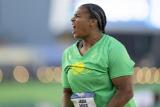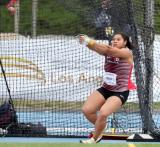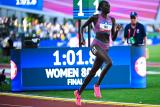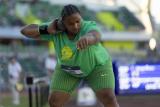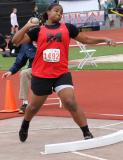Folders |
Oregon's Jaida Ross in Position to 'Shake Things Up' in Women's Shot PutPublished by
Collegiate Record Holder And Bowerman Award Finalist Jaida Ross of Oregon Faces Big Opportunity In Her 'Backyard' By Lori Shontz for DyeStat When the college coaches started calling, the coaches at North Medford High School couldn’t help but laugh. They knew what the college coaches saw in Jaida Ross, their star thrower and all-around A-plus teammate: a 6A state title as a freshman, then a big improvement her junior year and another state title. But what those recruiting her didn’t know was this: Ross was so busy with soccer, basketball, her schoolwork, a job and her family that early in her high school career, she made it to track practice only twice a week. Even as she began to focus more on throwing and improved her personal best to a 48-5 (14.75m) as a junior, she’d never lifted weights. More U.S. Oympic Team Trials - INTERVIEWS | PHOTOS “I’m telling these coaches, you have no idea how raw this young lady is,” said Aaron Williams, North Medford’s throws coach. “You get her into a weight room, you get her into a year-round program …” Even in 2023, Ross had finished fifth at NCAAs for the Oregon Ducks and sixth at the USATF Outdoor Championships, and her PR was 59-9.75 (18.23m). An All-American. A good thrower. But not a great one, not yet. Then came 2024. Heading into this weekend’s shot put competition at the 2024 U.S. Olympic Team Trials, the 22-year-old Ross is the reigning NCAA outdoor champion, the collegiate record holder in the shot put at 65-7.75 (20.01m), the architect of the best series in college history (four throws over 19m) and a finalist for the Bowerman Award. And this weekend at Hayward Field – “her backyard,” she calls it – Ross is among the favorites to make the Olympic team. “I know for most people, they’re like, ‘Where did she come from?’’’ Williams said. “We’re like, no. This has been in the making.” The Olympic Trials shot put field features two-time World champion Chase Jackson, Tokyo Olympics silver medalist Raven Saunders, two-time U.S. champion Maggie Ewen, and two-time NCAA champion Adelaide Aquilla. Ross, whose NCAA record throw is the second farthest by an American this season, is also one of the big names, although she said she doesn’t see herself that way. “I’m aware that I kind of am,” she said. “But I think mentally I’m going in as, ‘I’m a collegiate thrower – my big meet is NCAAs.’ This is my chance to shake some things up in the throws world, have some fun and see where the chips land.” Ross came to the attention of North Medford head track coach Pieter Voskes when she was in seventh grade. He was the middle school basketball coach, and when he watched her grab a rebound in practice and run down the court, he told her she needed to go out for track. Ross: Nope. I play basketball and soccer. The next week, Ross did it again. Voskes again suggested she try track. Eventually, Ross agreed to try it. One week. And that was all it took. “I was a multi-sport athlete, and I didn’t want to pick up track and field – I was busy with other sports,” Ross said. “I’m glad I’m here today, and every single person that’s part of my journey, I’m grateful for.” Voskes didn’t know he had just identified a girl who would become the best collegiate shot putter in history. What he saw: “An academically sound, hard-working kid who likes to compete.” As a freshman, she watched a senior teammate break the school shot put record … then broke it herself six days later. She won a state title using the glide. “When you’re young, throwing is just kind of getting reps in,” Ross said. “When I was in the younger days, it was just about learning how to love the sport, what shot put is.” She also ran the 100 meters and was a staple of the 4x100 relay. “Fastest woman in my high school, not to brag,” Ross said, smiling. “It was fun.” Sophomore year, her coaches began teaching her rotation, doing leg work; Williams said she was so stable on the balls of her feet that the transition was not as difficult as it is for some throwers. Voskes and Williams – with some help from the soccer coaches – also pushed her to attend a throwing camp. She ended up going to Iron Wood Thrower Development Camp in Post Falls, Idaho after her sophomore year, and that, Ross said, sold her on the sport. And not just because of the technique work. “When I got to high school, the biggest thing for me was seeing body diversity,” she said. “I grew up a soccer player, so I was around smaller people my whole life, and I was bigger. I was able to see that there are bigger people out there who are talented and gifted. “Going to a throws camp at Iron Wood, I got to see so much body diversity, that really made me fall in love with the sport. I felt like I belonged. I felt like I fit in.” Ross continued to play center back for the soccer team through her junior year, and she went back to basketball as a senior. Then the pandemic hit, and Ross lost her senior season. Her goals were to win state titles in the shot put and discus, which would have made her the most-decorated North Medford High female athlete, and to throw the shot 52 feet. (The state record is 52-7). Instead, she found herself practicing on her own. It was pretty easy to socially distance once she found a shot put ring, so she’d work on technique and send videos to her coaches. “She’d text us when we were supposed to have a meet – I threw 48-6 today,” Voskes said. “My hamstring’s a little tight. I’m working on a new stretching routine. She created her own artificial season.” Ross committed to Oregon before her truncated senior season, which allowed her to be close enough to her family to get home, far enough away to have her own space. It also allowed her to join a program with a strong throws tradition. She learned how to navigate the weight room and how to do Olympic lifts, something she’d never heard of. She gradually improved, finishing fifth at NCAA outdoors as a sophomore. And then Oregon made a coaching change, and new coach Jerry Schumacher brought in a new throws coach, Brian Blutreich, who taught a different technique from her previous coach, Erik Whitsitt. At 5-foot-6, Ross is shorter than most throwers, so she needs to make the most of her length. She said Blutreich’s technique has helped her to do so. Again, she continued to gradually improve. And she worked hard on what she now considers the key to her success: her mental fitness. Ross’ mom was a drug and alcohol counselor, and Ross wants to eventually go into a similar helping profession. She majored in psychology and is completing a master’s degree in prevention science, which has a heavy social work component. With that background, she put as much focus onto her mental preparation as her physical. “There’s lots of power and strength in using the mental side of athletics,” she said. On her Instagram, she posted her successes and also posted video of some of her weight room failures. “That’s to normalize it,” she said. “I think a lot of people just try to be perfect. I’m not one of those people. It’s important that people know I have hard days and I’m normal.” As a senior, Ross had her best NCAA finish at the NCAA Indoor Championships in March, a second place at 60-7.25 (18.47m), two inches behind Colorado State’s Mya Lesnar, who threw 60-9.50 (18.53m). And that was just a preview of the outdoor season to come. In her outdoor opener, she broke Aquilla’s collegiate record with a throw of 64-8 (19.71m). Three weeks later, she became the first woman to break the 19-meter barrier four times in a six-throw series, and one of those throws tied her NCAA record. By this time, she was getting buzz as a potential NCAA champion if not a potential Olympian, but at a press availability a few days later, she said was not thinking about what she’d need to for the two big needs in June, NCAAs and the Olympic Trials. “I don’t want to psych myself out thinking, ‘Oh, I have to be really good by June,’” she said in April. “I want to think, ‘Oh, we’re building to June.’ I come in every day, I do my drills, I do my throws, I lift, get stronger get better – and then I do the same thing the next day. And that’s just kind of where my mindset is.” And then at the NCAA West Regional meet, she became the first collegiate woman to break the 20-meter barrier. Ross said she’s still adjusting to the attention that comes with her performance; she said she doesn’t like the spotlight, and that was easier to avoid when she was playing team sports, not an individual one. This week, she’s got a bunch of air mattresses at her house to prepare for family and friends who are coming to watch her throw, and she’s preparing to compete Friday night in the preliminaries, then Saturday night in the final. She’s competed twice at USAs, finishing 11th in 2002 and sixth a year ago, and she said she’s ready for this weekend. “My first USAs I was really nervous, and my second USAs I was more focused, a little more locked in mentally and things like that,” Ross said. “It’s kind of prepared me now. I’ve seen a lot of these people throw. I’ve competed against these women before. Just having the experience behind me helps with the confidence a little bit.” More news |


